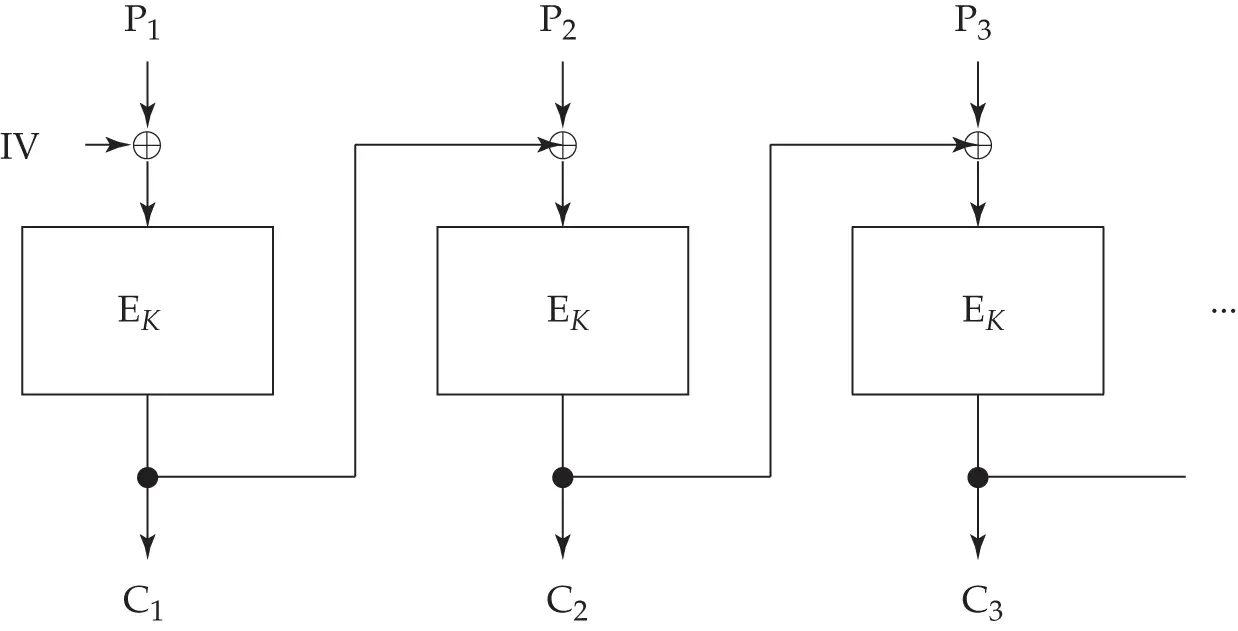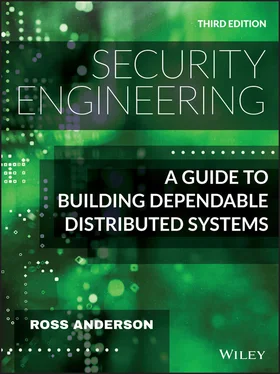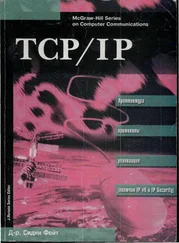Most commercial applications which encrypt more than one block used to use cipher block chaining, or CBC, mode. Like ECB, this was one of the original modes of operation standardised with DES. In it, we exclusive-or the previous block of ciphertext to the current block of plaintext before encryption (see Figure 5.15).
This mode disguises patterns in the plaintext: the encryption of each block depends on all the previous blocks. The input initialisation vector (IV) ensures that stereotyped plaintext message headers won't leak information by encrypting to identical ciphertexts, just as with a stream cipher.
However, an opponent who knows some of the plaintext may be able to cut and splice a message (or parts of several messages encrypted under the same key). In fact, if an error is inserted into the ciphertext, it will affect only two blocks of plaintext on decryption, so if there isn't any integrity protection on the plaintext, an enemy can insert two-block garbles of random data at locations of their choice. For that reason, CBC encryption usually has to be used with a separate authentication code.
More subtle things can go wrong, too; systems have to pad the plaintext to a multiple of the block size, and if a server that decrypts a message and finds incorrect padding signals this fact, whether by returning an ‘invalid padding’ message or just taking longer to respond, then this opens a padding oracle attack in which the attacker tweaks input ciphertexts, one byte at a time, watches the error messages, and ends up being able to decrypt whole messages. This was discovered by Serge Vaudenay in 2002; variants of it were used against SSL, IPSEC and TLS as late as 2016 [1953].

Figure 5.15 : Cipher Block Chaining (CBC) mode
Feedback modes of block cipher encryption are falling from fashion, and not just because of cryptographic issues. They are hard to parallelise. With CBC, a whole block of the cipher must be computed between each block input and each block output. This can be inconvenient in high-speed applications, such as protecting traffic on backbone links. As silicon is cheap, we would rather pipeline our encryption chip, so that it encrypts a new block (or generates a new block of keystream) in as few clock ticks as possible.
The simplest solution is to use AES as a stream cipher. We generate a keystream by encrypting a counter starting at an initialisation vector:  , thus expanding the key
, thus expanding the key  into a long stream of blocks
into a long stream of blocks  of keystream, which is typically combined with the blocks of a message
of keystream, which is typically combined with the blocks of a message  using exclusive-or to give ciphertext
using exclusive-or to give ciphertext  .
.
Additive stream ciphers have two systemic vulnerabilities, as we noted in section 5.2.2above. The first is an attack in depth: if the same keystream is used twice, then the xor of the two ciphertexts is the xor of the two plaintexts, from which plaintext can often be deduced, as with Venona. The second is that they fail to protect message integrity. Suppose that a stream cipher were used to encipher fund transfer messages. These messages are highly structured; you might know, for example, that bytes 37–42 contain the sum being transferred. You could then cause the data traffic from a local bank to go via your computer, for example by an SS7 exploit. You go into the bank and send $500 to an accomplice. The ciphertext  , duly arrives in your machine. You know
, duly arrives in your machine. You know  for bytes 37–42, so you can recover
for bytes 37–42, so you can recover  and construct a modified message which instructs the receiving bank to pay not $500 but $500,000! This is an example of an attack in depth ; it is the price not just of the perfect secrecy we get from the one-time pad, but of much more humble stream ciphers, too.
and construct a modified message which instructs the receiving bank to pay not $500 but $500,000! This is an example of an attack in depth ; it is the price not just of the perfect secrecy we get from the one-time pad, but of much more humble stream ciphers, too.
The usual way of dealing with this is to add an authentication code, and the most common standard uses a technique called Galois counter mode, which I describe later.
5.5.4 Legacy stream cipher modes
You may find two old stream-cipher modes of operation, output feedback mode (OFB) and less frequently ciphertext feedback mode (CFB).
Output feedback mode consists of repeatedly encrypting an initial value and using this as a keystream in a stream cipher. Writing IV for the initialization vector, we will have  and
and  . However an
. However an  -bit block cipher in OFB mode will typically have a cycle length of
-bit block cipher in OFB mode will typically have a cycle length of  blocks, after which the birthday theorem will see to it that we loop back to the IV. So we may have a cycle-length problem if we use a 64-bit block cipher such as triple-DES on a high-speed link: once we've called a little over
blocks, after which the birthday theorem will see to it that we loop back to the IV. So we may have a cycle-length problem if we use a 64-bit block cipher such as triple-DES on a high-speed link: once we've called a little over  pseudorandom 64-bit values, the odds favour a match. (In CBC mode, too, the birthday theorem ensures that after about
pseudorandom 64-bit values, the odds favour a match. (In CBC mode, too, the birthday theorem ensures that after about  blocks, we will start to see repeats.) Counter mode encryption, however, has a guaranteed cycle length of
blocks, we will start to see repeats.) Counter mode encryption, however, has a guaranteed cycle length of  rather than
rather than  , and as we noted above is easy to parallelise. Despite this OFB is still used, as counter mode only became a NIST standard in 2002.
, and as we noted above is easy to parallelise. Despite this OFB is still used, as counter mode only became a NIST standard in 2002.
Cipher feedback mode is another kind of stream cipher, designed for use in radio systems that have to resist jamming. It was designed to be self-synchronizing, in that even if we get a burst error and drop a few bits, the system will recover synchronization after one block length. This is achieved by using our block cipher to encrypt the last  bits of ciphertext, adding the last output bit to the next plaintext bit, and shifting the ciphertext along one bit. But this costs one block cipher operation per bit and has very bad error amplification properties; nowadays people tend to use dedicated link layer protocols for synchronization and error correction rather than trying to combine them with the cryptography at the traffic layer.
bits of ciphertext, adding the last output bit to the next plaintext bit, and shifting the ciphertext along one bit. But this costs one block cipher operation per bit and has very bad error amplification properties; nowadays people tend to use dedicated link layer protocols for synchronization and error correction rather than trying to combine them with the cryptography at the traffic layer.
Читать дальше


 , thus expanding the key
, thus expanding the key  into a long stream of blocks
into a long stream of blocks  of keystream, which is typically combined with the blocks of a message
of keystream, which is typically combined with the blocks of a message  using exclusive-or to give ciphertext
using exclusive-or to give ciphertext  .
. , duly arrives in your machine. You know
, duly arrives in your machine. You know  for bytes 37–42, so you can recover
for bytes 37–42, so you can recover  and construct a modified message which instructs the receiving bank to pay not $500 but $500,000! This is an example of an attack in depth ; it is the price not just of the perfect secrecy we get from the one-time pad, but of much more humble stream ciphers, too.
and construct a modified message which instructs the receiving bank to pay not $500 but $500,000! This is an example of an attack in depth ; it is the price not just of the perfect secrecy we get from the one-time pad, but of much more humble stream ciphers, too. and
and  . However an
. However an  -bit block cipher in OFB mode will typically have a cycle length of
-bit block cipher in OFB mode will typically have a cycle length of  blocks, after which the birthday theorem will see to it that we loop back to the IV. So we may have a cycle-length problem if we use a 64-bit block cipher such as triple-DES on a high-speed link: once we've called a little over
blocks, after which the birthday theorem will see to it that we loop back to the IV. So we may have a cycle-length problem if we use a 64-bit block cipher such as triple-DES on a high-speed link: once we've called a little over  pseudorandom 64-bit values, the odds favour a match. (In CBC mode, too, the birthday theorem ensures that after about
pseudorandom 64-bit values, the odds favour a match. (In CBC mode, too, the birthday theorem ensures that after about  blocks, we will start to see repeats.) Counter mode encryption, however, has a guaranteed cycle length of
blocks, we will start to see repeats.) Counter mode encryption, however, has a guaranteed cycle length of  rather than
rather than  , and as we noted above is easy to parallelise. Despite this OFB is still used, as counter mode only became a NIST standard in 2002.
, and as we noted above is easy to parallelise. Despite this OFB is still used, as counter mode only became a NIST standard in 2002. bits of ciphertext, adding the last output bit to the next plaintext bit, and shifting the ciphertext along one bit. But this costs one block cipher operation per bit and has very bad error amplification properties; nowadays people tend to use dedicated link layer protocols for synchronization and error correction rather than trying to combine them with the cryptography at the traffic layer.
bits of ciphertext, adding the last output bit to the next plaintext bit, and shifting the ciphertext along one bit. But this costs one block cipher operation per bit and has very bad error amplification properties; nowadays people tend to use dedicated link layer protocols for synchronization and error correction rather than trying to combine them with the cryptography at the traffic layer.









